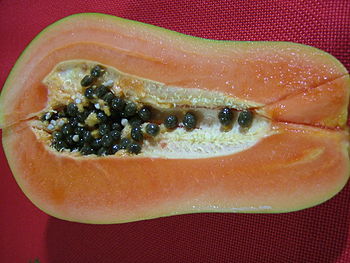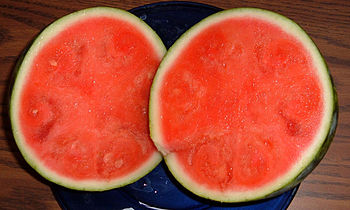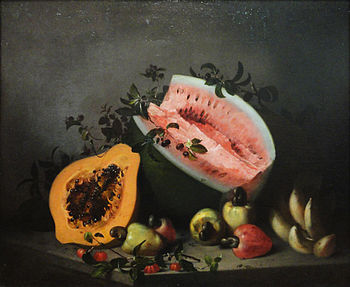Incidentally I have found two new foods that diminish Parkinson’s tremors: watermelon and papaya. I learned about them from a Parkinson’s blogger who calls herself Aunt Bean (after the fava and mucuna beans she grows for PD.) Apparently the late pope used fermented papaya and Aunt Bean has a recipe here. I started out fermenting them. Watermelon was easy: I scooped the pulp into a blender, liquified it and added water kefir grains. It soon turned into a bubbling sour drink. The papaya was harder: I mashed the pulp and fermented it but needed to dry it on fruit leather trays which I don’t have for my dehydrator.

But I also read comments that the unfermented food worked and I noticed that raw watermelon and papaya seemed to reduce tremors. Fermentation does reduce sugar and add probiotics but it doesn’t keep very long. So my dehydrator is going, full of papaya slices (the watermelon is done.)
Now I had no idea why watermelon and papaya work, and they are hardly a cure. But it was tasty and easy to incorporate into a daily diet. I still take the fava beans (note that dopamine medication could interact) but I don’t take them every day any more.
So I went on a search. In Chinese Medicine watermelon is considered a cold medicinal herb, used to drain heat out of the body through the urine and to replenish fluids. Xi gua (watermelon) is known to clear heat, replenishes fluids, regulate urination and expel jaundice- it is used in hepatitis treatment. While the materia medica says that it goes to the Heart, Bladder and Stomach but not the liver, the attributes or meridians named after organs are not identical with those attributed to organs by Western medicine The jaundice and hepatitis indications made me think of the liver and I guessed that glutathione production might be affected. And in fact while I still needed to check scholarly sources, Dr. Oz cites watermelon as a rich source of glutathione. And although short-lived and poorly absorbed from pills, glutathione does reduce tremors.
Watermelon provides 28 milligrams of glutathione per 100 gram portion. A perusal of PubMed shows that watermelon extract can mitigate oxidative damage from X-rays or genotoxicity and neurological balance. To use or make glutathione we need water which is in abundance in watermelon. If we are dehydrated we may not make as much glutathione as we could.
Now papaya fruit is not in the Chinese Materia Medica, but I checked PubMed using “Papaya and Glutathione” as search terms. And, Bingo! “A glutathione S-transferase inducer from papaya: rapid screening, identification and structure-activity relationship of isothiocyanates.” Papaya induces glutathione.

Glutathione, a compound containing three amino acids, glutamate, cysteine and glycine, is the body’s master antioxidant and when its production is damaged a variety of things can go wrong including tremors. IV glutathione is given in a push to stop symptoms of Parkinson’s Disease but the IVs are recommended 3-7 times a week, not covered by insurance. The landmark glutathione Parkinson’s study, “Reduced intravenous glutathione in the treatment of early Parkinson’s disease.‘, was done by the Department of Neurology, University of Sassari, Italy in 1996. In this study all patients improved significantly after glutathione therapy with a 42% decline in disability. Neurologist Dr. Daniel Perlmutter has been giving it to PD patients since 1998.
Now I would not be so reductionist as to say that it is only glutathione that makes watermelon or papaya work. Watermelon hydrates which provides the a matrix for the hydronium ions that carry qi through fluids, It is high in flavanoids Vitamin A, Vitamin C, B vitamins, and potassium, not to mention cirtulline and lycopene, One slice of watermelon (485 g) contains 152 calories, 3 g protein, 34.6 g carbohydrates, 2.4 g fiber, 560 mg potassium, 176 mg vitamin A (RE), 47 mg vitamin C, 8..5 mg choline, 0.1 mg riboflavin, and 0.96 mg niacin.
Papaya contains enzymes that induce glutathione S-transferase. Papaya latex contains at least four cysteine endopeptidases and other constituents including hydrolase inhibitors and lipase. It has rather high levels of potassium and significant levels of calcium and magnesium. Vitamin C, Vitamin A. A small fruit (157 g) contains 67 calories, 0g protein, 17 g carbohydrates, 2.7 g fiber, 286 mg potassium, 1531 IU vitamin A (RE), 86.5 mg vitamin C, 15 mg folate and 0.5 mg niacin. Since the enzymatic effect is important one should avoid irradiated papayas to get the best effect.
There is evidence that a yeast fermented preparation of papaya is more effective than fresh or dried papaya. It reduces oxidative stress and has been found to protect the brain from oxidative damage in hypertensive rats. Pope John Paul ll was prescribed an experimental treatment made from a fermented papaya to ease symptoms of Parkinson’s disease, I suspect that the fermentation makes a difference compared to dried or raw papaya.
So incorporating watermelon and fermented papaya is an easy way to reduce symptoms. Other fruits that also have glutathione and are rich in antioxidants are berries, oranges, pomegranate, apricots, prunes, avocado, grapefruit, strawberries, peaches, cinnamon, asparagus, legumes, nuts, spinach and bell peppers. Or eat cysteine-rich food including dairy products such as cheese,yogurt and chicken breast since cysteine is used in glutathione synthesis. Add a couple of Brazil Nuts for selenium (or tuna, beef, walnuts, eggs, cottage cheese, or turkey) and we are set!
See Also:
Experimental Treatment for Parkinson’s
Nutrition for Parkinson’s Disease- Part 1
What Not To Eat With Parkinson’s Disease,Part 2
Useful Supplements for Parkinson’s Disease: Part 3
Special issues with Parkinson’s and Nutrition: Part 4
Eating Watermelon for Parkinson’s Symptoms


